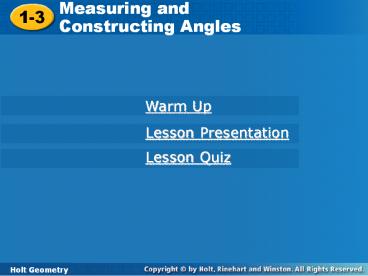Measuring and - PowerPoint PPT Presentation
Title:
Measuring and
Description:
1-3 Warm Up Lesson Presentation Lesson Quiz Holt Geometry Measuring and Constructing Angles Holt Geometry 1-3 Measuring and Constructing Angles ... – PowerPoint PPT presentation
Number of Views:158
Avg rating:3.0/5.0
Title: Measuring and
1
Measuring and Constructing Angles
1-3
Warm Up
Lesson Presentation
Lesson Quiz
Holt Geometry
2
31
3
Objectives
TSW name and classify angles. TSW measure and
construct angles and angle bisectors.
4
Surveyors use angles to help them measure and map
the earths surface.
5
Vocabulary
angle right angle vertex obtuse
angle interior of an angle straight
angle exterior of an angle congruent
angles measure angle bisector degree acute
angle
6
A transit is a tool for measuring angles. It
consists of a telescope that swivels horizontally
and vertically. Using a transit, a survey or can
measure the angle formed by his or her location
and two distant points.
An angle is a figure formed by two rays, or
sides, with a common endpoint called the vertex
(plural vertices). You can name an angle several
ways by its vertex, by a point on each ray and
the vertex, or by a number.
7
The set of all points between the sides of the
angle is the interior of an angle. The exterior
of an angle is the set of all points outside the
angle.
Angle Name ?R, ?SRT, ?TRS, or ?1
You cannot name an angle just by its vertex if
the point is the vertex of more than one angle.
In this case, you must use all three points to
name the angle, and the middle point is always
the vertex.
8
Example 1 Naming Angles
A surveyor recorded the angles formed by a
transit (point A) and three distant points, B, C,
and D. Name three of the angles.
Possible answer
9
Example 2
Write the different ways you can name the angles
in the diagram.
10
(No Transcript)
11
You can use the Protractor Postulate to help you
classify angles by their measure. The measure of
an angle is the absolute value of the difference
of the real numbers that the rays correspond with
on a protractor.
12
(No Transcript)
13
Example 3 Measuring and Classifying Angles
Find the measure of each angle. Then classify
each as acute, right, or obtuse.
?YXZ ?ZXV ?YXW ?ZXW ?WXV
14
Example 4
Use the diagram to find the measure of each
angle. Then classify each as acute, right, or
obtuse.
?AOD ?EOC ?COD ?BOA ?DOB
15
Congruent angles are angles that have the same
measure. In the diagram, m?ABC m?DEF, so you
can write ?ABC ? ?DEF. This is read as angle
ABC is congruent to angle DEF. Arc marks are
used to show that the two angles are congruent.
The Angle Addition Postulate is very similar to
the Segment Addition Postulate that you learned
in the previous lesson.
16
(No Transcript)
17
(No Transcript)
18
Example 5 Using the Angle Addition Postulate
m?DEG 115, and m?DEF 48. Find m?FEG
19
Example 6
m?XWZ 121 and m?XWY 59. Find m?YWZ.
20
Example 6a m?ABD 37 and mltBC 84. Find
m?DBC.
Example 6b m?XWZ 121 and m?XWY 59. Find
m?YWZ.
21
(No Transcript)
22
(No Transcript)
23
Example 7 Finding the Measure of an Angle
24
Example 8
Find the measure of each angle.
25
Example 9
Find the measure of each angle.
26
Example 10
A surveyor at point S discovers that the angle
between peaks A and B is 3 times as large as the
angle between peaks B and C. The surveyor knows
that ?ASC is a right angle. Find m?ASB and
m?BSC.
27
(No Transcript)
28
Lesson Quiz Part I
Classify each angle as acute, right, or obtuse.
1. ?XTS
2. ?WTU
3. K is in the interior of ?LMN, m?LMK 52, and
m?KMN 12. Find m?LMN.
29
Lesson Quiz Part II
5. Use a protractor to draw an angle with a
measure of 165.
30
Lesson Quiz Part III
6. m?WYZ (2x 5) and m?XYW (3x 10). Find
the value of x.
31
Lesson Quiz Part I
Classify each angle as acute, right, or obtuse.
1. ?XTS
acute
right
2. ?WTU
3. K is in the interior of ?LMN, m?LMK 52, and
m?KMN 12. Find m?LMN.
64
32
Lesson Quiz Part II
32
5. Use a protractor to draw an angle with a
measure of 165.
33
Lesson Quiz Part III
6. m?WYZ (2x 5) and m?XYW (3x 10). Find
the value of x.
35































